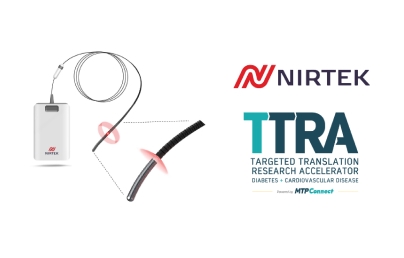Nirtek’s Guidewire for Unstable Plaque Detection – Finding Ticking Time-Bombs to Prevent Heart Attack

Cardiovascular Disease is the leading cause of death worldwide, responsible for one third of all global mortality. Of these fatalities, a staggering 85 per cent are attributed to heart attacks and strokes1. In Australia, heart attacks alone account for nearly one in 20 deaths – this equates to a heart attack claiming a life every 74 minutes, or on average 19 people every day2. These alarming statistics underscore the pressing need for innovative solutions.
A diagnostic guidewire being developed by Nirtek – a company formed to prevent heart attacks and save lives – is providing new optimism in the battle against this formidable health challenge. The science behind the technology was discovered by leading interventional cardiologist and Deputy Director of the Baker Heart and Diabetes Institute, Professor Karlheinz Peter, with the clinical need for the product identified through his daily insight treating patients.
Despite the presence of diagnosed coronary artery disease, many individuals continued to suffer major adverse cardiovascular events, including heart attacks and even death. The clear unmet need was to identify unstable plaques within coronary arteries that were vulnerable to rupture. In the absence of a reliable means of detecting their instability. Plaques often go untreated, leaving what Professor Peter describes as a ticking time bomb.
Unstable plaques could be detected and rapidly treated
The core science behind Nirtek’s technology is certain compounds within plaques that are strongly correlated with instability, produce a specific auto-fluorescence signal when stimulated with near infrared light. Nirtek realised that if this could be measured during routine angiography procedures, unstable plaques could be detected and rapidly treated before they rupture and block the artery.
Collaborating with optical physicists and biomedical engineers at Swinburne University of Technology, the company Nirtek was created with the vision to develop a Near Infrared Auto-fluorescence (NIRAF) Guidewire using this discovery.
The NIRAF Guidewire is an intracoronary device capable of directing near infrared light at a coronary plaque, analysing its instability and vulnerability to rupture, and directing the need to interventional therapy such as coronary stenting or targeted drug therapy.
Through the inaugural round of the Targeted Translation Research Accelerator (TTRA) Research Projects opportunity, Nirtek was awarded $750,000 in 2021 along with support from TTRA Partner, the Medical Device Partnering Program (MDPP).
Pictured: Neo-Bionica mechatronics engineer Ioanna Stamatopoulos preparing guidewire testing rig.
Prior to being awarded TTRA funding, the NIRAF Guidewire was at technology readiness level (TRL) 3 – the underlying science had been established and some proof-of-concept sub-components of the device had been designed and tested, but only in a research laboratory environment. The goal of the TTRA-funded project was to transition into formal product development to create a prototype of both the guidewire and its associated controller device, ready for rigorous testing in representative environments and eventually humans.
Accelerating project development, reaching TRL5 and building a demo prototype
In just under 21 months, Nirtek significantly accelerated product development, reaching TRL5 and successfully building a functional concept demonstrator prototype (CDP) of the NIRAF Guidewire and controller. The guidewire is almost two metres long, yet only the thickness of a few human hairs. Laser light is directed via optical fibres through its length to the tip, where a specially designed reflector transmits the laser light into a plaque and detects autofluorescence signatures that are unique to plaques that are unstable and at risk of rupture causing heart attack.
Nirtek’s guidewire looks, feels and reacts just like the off-the-shelf guidewires used in clinical practice by interventional cardiologists every day. This is essential to ensure that the NIRAF Guidewire can be used by clinicians without having to change the way they perform procedures or undergo retraining. Voice of Customer interviews with interventional cardiologists were built into the TTRA project, ensuring user requirements were central to the device’s development.
Coinciding with the technology’s progress, the project also realised significant intellectual property milestones, with patents granted in the US, EU, Australia and Japan. These achievements confirm the pioneering nature of the NIRAF Guidewire technology.
It was also essential that the development of the NIRAF Guidewire proceeded in such a way as to meet regulatory standards. To ensure this, Nirtek established a robust quality management system to govern all research and development activities. The prototype device has now been tested and proven to successfully detect unstable plaques in artificial models and genuinely representative biological samples, including mouse models and ex vivo human samples. With a small amount of further testing and design refinement, the device will be ready for first-in-human clinical testing.
Nirtek Chief Technical Officer Paul Stoddart testing prototype device on an unstable plaque sample.
TTRA program – much more than just funding
When asked what being part of the TTRA program meant for the company and project, Nirtek Managing Director and CEO Matthew Hoskin said the program had provided more than just funding.
“The TTRA funding for this project is dependent on significant vetting and diligence being conducted by an independent body, who in turn is answerable to government,” Hoskin said.
“For Nirtek, this is a form of validation for not only our company and product, but also for our management and governance. This provides a level of credibility and trust that may otherwise be difficult for a small start-up to demonstrate to others including potential partners, service providers, contractors and investors.”
Similarly, Nirtek derived substantial value from the support offered through the TTRA program from MDPP.
“The relationship was one of genuine partnership, and our TTRA partner has felt like almost an extension of our own resources, always available for consultation but, importantly, also willing to take on tasks that contribute to the progress of the project.
“The advice from MDPP further propelled the project towards success including introduction to potential investors, brokers and related parties, assisting our capital raising effort and helping us to secure vital additional external investment funding,” Hoskin said.
Successful collaboration and partnership
The impact of Nirtek’s TTRA project transcends technical advancements and at the heart of Nirtek’s success is a story of collaboration and partnership, beginning with the clinicians, scientists and engineers at the Baker Institute and Swinburne University. The TTRA program funding allowed Nirtek to build on this and gave the company the necessary resources to take advantage of a thriving local ecosystem, including establishing lasting partnerships with key R&D service providers – Neo-Bionica and Exa Product Development (Exa PD), among others. These key partnerships were critical to progress the development of the NIRAF Guidewire.
For Exa PD and Neo-Bionica, the relationship with Nirtek is greater than simply fee-for-service, with both companies deeply committed to the success of the NIRAF Guidewire and excited about the future possibilities.
Exa PD founder and Engineering Manager, Stephen Leahey said: “With its innovative, high-tech approach and strong technical foundation, the solution has immense potential to benefit patients. We are excited to be part of this remarkable endeavour, to make a meaningful impact in healthcare.”
Pictured: Exa PD electronics engineer Tim Atkinson optimising controller electronics.
Exciting, smart diagnostic device to prevent heart attack
Neo-Bionica CEO Dr Ludovic Labat said: “Neo-Bionica is very proud to work with Nirtek as a commercialisation and manufacturing partner. We look forward to continuing to support Nirtek as the company brings its exciting, smart diagnostic device to prevent heart attacks to market.”
These partnerships have a circular effect – not only do these deep tech service providers contribute to the advancement of the NIRAF Guidewire, but the collaboration also enhances their company’s skills, capabilities and know-how, and further develops their partnerships and future work opportunities.
Mr Hoskin said the project’s success is a testament to the transformative potential of partnerships.
‘The team hopes to make Nirtek and our NIRAF Guidewire an example of what our local medtech ecosystem can achieve – the successful translation of targeted research through to the global launch of a novel medical device that will solve a major clinical problem, serve an enormous global commercial market, and save the lives of those at risk of heart attack from sudden plaque rupture,” Hoskin said.
The next phase for Nirtek is to ready a prototype device for a first-in-human clinical trial. This trial, conducted on a small number of patients, will evaluate product usability performance in the intended environment. The NIRAF Guidewire project embodies a beacon of hope for millions worldwide and, as the TTRA project concludes, Nirtek stands on the precipice of a transformative breakthrough in preventing heart attack.
1 WHO Factsheets, Cardiovascular Diseases (CVDs)
This article originally appeared on MTPConnect.com.au
